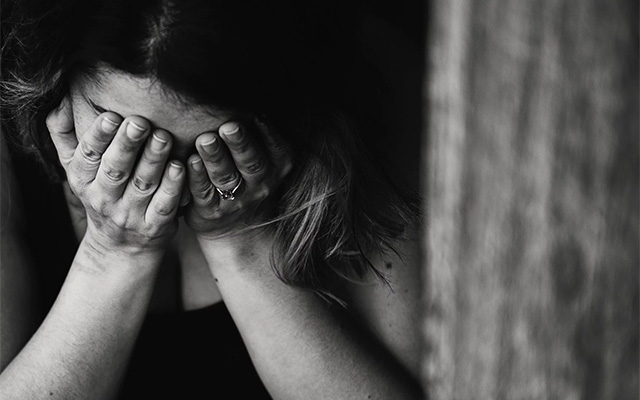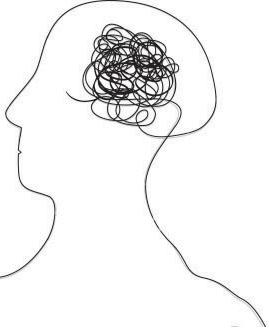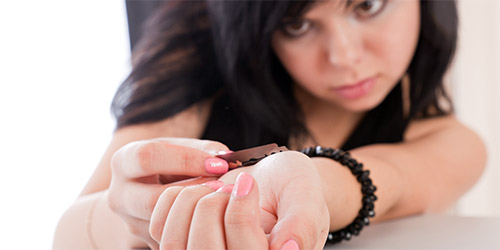
It’s more than just a mark on your body.
Self-harm goes deep with its emotional origins and potential dangers.
At 16, Rachael was dealing with a lot of difficult things: her boyfriend was beating her, she was having problems with her parents, and she wasn’t doing well in school. Not knowing how to cope with it all, she started hurting herself.
“I felt the pain on the inside and I wanted to feel the pain on the outside,” explains the now 19-year-old from Madison, Wisconsin, who’s featured in a new documentary called CUT: Teens and Self Injury (www.cutthemovie.com).
“I really didn’t have anyone to talk to…and self-harming felt like the only thing I could do to make myself feel better.” At first, she injured herself with a sharp object whenever she was having a hard time, but after a while she started doing it out of boredom, because she didn’t have anything else to do.
 Rachael’s not the only person to struggle with self-harm. Experts aren’t sure exactly how many Canadians self-injure, but it is more common with females than males and with teens than adults—self-harm typically begins in early adolescence, according to the Canadian Health Network.
Rachael’s not the only person to struggle with self-harm. Experts aren’t sure exactly how many Canadians self-injure, but it is more common with females than males and with teens than adults—self-harm typically begins in early adolescence, according to the Canadian Health Network.
The Reasons Why
Some people may think teens who injure themselves with sharp objects do so because they’re trying to commit suicide, but that’s often not the case. Usually self-harm, which leaves behind scratches or marks on the body, is an attempt to deal with tough stuff—basically it’s a very unhealthy coping mechanism. “[The reasons people self-harm] has to do with difficulty handling intense emotional states and being able to identify those emotions, to express them to others or to tolerate them,” says Dr. Wendy Lader, co-founder and clinical director of S.A.F.E (Self-Abuse Finally Ends) Alternatives based in Chicago. As well, those who self-injure sometimes do it as a way to feel something when they’re generally numbed out, or as a way to punish themselves when they feel worthless, according to Cheryl Rolin-Gilman, an advanced practice nurse at the Centre for Addiction and Mental Health in Toronto.
When teens like Rachael often self-harm to attempt feeling better, they’re not proud of it. It’s often kept a big secret, done in private and inflicted on parts of the body that can be covered up by clothing. There’s a lot of shame and embarrassment wrapped up in it.
“After [self-injuring] I felt really upset with myself,” Rachael says. “I thought, ‘why would I do that to myself to make myself feel better?’ It didn’t seem right to me, but I did it for three years.”
| Did You Know? Self-injury is often, though not always, a symptom of an underlying issue, such as depression, anxiety disorder, borderline personality disorder and eating disorders, according to Dr. Wendy Lader, co-founder and clinical director of S.A.F.E Alternatives. |

Addicted to Self-Abuse
Just like smoking, drinking, and drugs, self-harm can be habit forming. Often, teens get hooked on it because they’re desperate to numb their emotional pain, which some say it does temporarily. “Also, your body reacts to the injury by releasing a rush of endorphins and that can be addictive,” says Shannon, a Toronto-based counsellor from the Kids Help Phone. Wounds to the skin can lead to some serious physical risks, such as infection, abscesses, and severe blood loss if the cut is deep, which can also lead to shock, says Rolin-Gilman. As with any addiction, over time people stop feeling the rush or relief from what they’re doing, so they start doing more to get the same effect, which is very dangerous.
The Effects on Others
While self-injury is difficult on the person doing it, it’s also tough on those who care about them. “Friends and family often worry about the person they know is self-harming,” says Shannon. “This can cause a lot of stress—a lot of people don’t know what to do for them.” The best thing to do is be nonjudgmental and help them get professional support, as self-harm isn’t an issue a friend or family member can solve.
Reach for a Helping Hand
Some teens outgrow self-harming behaviour, never to struggle with it again; some stop injuring themselves only to have it pop up again later in life because they didn’t deal with the underlying issues; and others don’t stop and the self-abuse gets dangerously worse and disables much of their life, says Lader. Unfortunately, there’s no way to know what scenario they’ll end up with. So, the best insurance for a happy, healthy life is to seek professional help. With regular counselling, teens come to understand their emotions and how to appropriately express them and learn healthier alternatives to self-harm.
Recovery hasn’t been easy for Rachael, but she’s committed to it. It’s been over a year since she self-injured, thanks to counselling and her own hard work. Rachael wishes she never started self-harming, and hates that her body is scarred for life. She urges teens who are hurting themselves to get help. “Life gets hard for everyone but self-injury isn’t the thing to do,” Rachael says. “Try to find someone that you can trust and tell them how you feel and why you feel that way. Because someday you may really hurt yourself and may not live to see the next day.”

SOS Looking for Help?
- Talk to a teacher you trust or the school guidance counsellor and ask for help.
- Contact the Kids Help Phone, 1-800-668-6868. Counsellors are available 24/7 and the call is anonymous and free. Counsellors also answer posted questions on the website, www.kidshelpphone.ca
- Visit www.selfinjury.com
Signs of Self-Injury
Concerned that someone you care about is self-harming?Here are some self-injury signs to look for:
1. Scratches or marks on their body
2. Mood swings
3. Covering up in long tops and/or pants in the summer, or refusing to go swimming when they’ve always loved to swim
4. Bloody tissues
5. Not talking about tough issues that they’re experiencing
Written for Faze by Aileen Brabazon

Comments are closed.